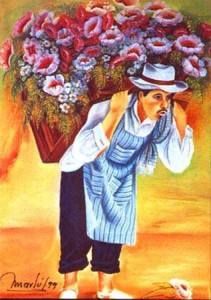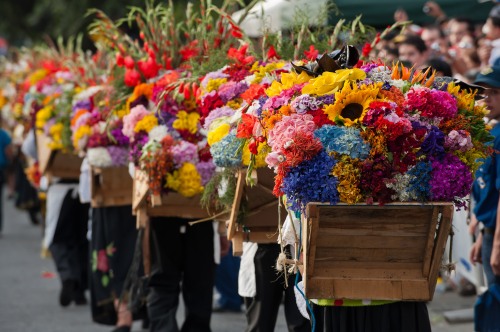One cold Saturday, Oscar and I visited Dingli Cliffs for Oscar to enjoy Maltese food and discover a new part of the island. Horse meat was on the menu and this was a strange experience for Oscar. In Colombia, where he comes from, horses are held in high regard and it is illegal to sell horsemeat. Inspired by our project, Ħwawar u Fjuri, I asked Oscar what has become a standard question in my encounters: to tell me about the flowers in Colombia. The first images that came to his mind were of the ancient trees that can be found in Colombia which produce tropical flowers, and the beautiful places around the Amazon River where a diversity of animals live. He vividly remembered the parrots and small monkeys.Oscar told me that, in Colombia, flowers are used as decorations: for special and joyous occasions such as weddings and parties. Flowers are also used for funerals, and are taken to the cemetery, as they are in our own culture, here in Malta. In Colombia, Oscar remembered, it is traditional to place a crown of flowers on and around the coffin.

Another Colombian tradition Oscar remembered was that people enjoyed relaxing by having baths using fresh flower petals, generally of roses or sun flowers, which are boiled for an hour with a little honey added to the mix. Sometimes a puff or two of one’s own perfume is added. The mixture is added to the bath, and is believed to be revitalizing. Other flowers can also be used, and usually petals are bought, so long as they are fresh. Another belief linked to this bath held by some people in Colombia is that it helps to attract good experiences in life. This is not a widely shared belief, but, whatever one believes in, a bath with flower petals can certainly be a positive response to difficult moments.
Oscar remembered how in Colombia rose petals are also used to prepare a rose-dessert, which is very popular. I mentioned to Oscar that in Malta rose-vinegar used to be popular, although it no longer is today. Another tradition Oscar remembered was that in Colombia bitter plants, herbs and flowers are used to make a variety of teas, several of which are also used to refresh one’s own body. The plants used always originate in Colombia. Colombians like to drink tea, using flowers like ‘Manzanilla’ – Chamomile–which is also used to cure sickness. I mentioned that in Malta we also like to drink Chamomile tea but he emphasized that in Colombia people prefer to use fresh or dried flowers rather than ready-made teabags. Another flower Oscar identified as popularly used in Colombia is ‘Calendula’, known as ’marigold’ in English. It is believed that the tea from this flower helps the body to regenerate and heal scars: a belief Oscar defends from his own experience of drinking Calendula tea to help with his recovery process after having had an appendix operation.
In Colombia, flowers are widely used to organize feasts, or ‘Carnaval’. In the city of Medellin a very special feast is organized, called ‘La Feria de las Flores’. Oscar explained that this is a yearly tradition. Colombian flowers are used for the festival, and people use flowers in the parade that takes place during the feast. Oscar wanted me to look up online pictures of this event, which I did. The festival is organized in August, and a lot of people visit Medellin to participate in it. The pictures look stunning. ‘La Feria de las Flores’ is on Oscar’s to-do list.

On the other hand, Oscar pointed out that Saint Valentine’s day is not an important occasion in Colombia, but a similar day is celebrated instead in September: a feast called ‘De Amor Y Amistad’. This is a day where everyone buys a rose to give to someone else, to celebrate both love and friendship. Similarly, on women’s day, women are given roses. In his childhood, Oscar recalls that he often used to cut a rose from the neighbour’s garden to give to his mother on women’s day and, when he could not find a rose, he would paint one for her.
Shifting his attention to other aspects of flowers in Colombia, he pointed out that the country produces and even exports flowers, despite being more famous for its coffee. He pointed out that Columbia has emerged as the second largest international exporter of flowers as a result of the beautiful, colourful, varied and good quality flowers it produces.
At the end of our conversation Oscar pointed out that, culturally, the most important tree in Colombia is the ‘Palma de Cera’, which represents national identity, and is emblematic of the country, as, in flower form, does the orchid. Oscar emphasized that the ‘Palma de Cera’ holds a special meaning for people in Colombia, and the awareness of its importance is transmitted from one generation to the next.











































































